In the age of rapid communication, texting has become one of the most popular ways to stay in touch. Whether it’s quick messages between friends, coordinating with colleagues, or even catching up with family, we rely on texting for its convenience. But with the rise of this digital interaction comes a new language—abbreviations. These shortcuts save time, space, and effort while communicating online. If you’ve ever felt confused by a string of letters, you’re not alone. In this article, we’ll break down the most common abbreviations used in texting and online messaging.
Why Are Abbreviations So Popular?
Abbreviations aren’t just about laziness or trying to be “cool.” They’re a response to the fast-paced nature of online communication. Many of us text on the go, during breaks, or in between tasks. Using abbreviations allows us to type quickly without losing the essence of our message. Plus, on platforms like Twitter and Instagram, where character limits are imposed, abbreviations help us say more with fewer characters.
Common Abbreviations You Need to Know
If you’re new to texting or simply want to stay updated with the latest lingo, here are some of the most commonly used abbreviations:
- LOL – Laughing Out Loud
- BRB – Be Right Back
- TTYL – Talk To You Later
- OMG – Oh My God
- IDK – I Don’t Know
- FYI – For Your Information
- BTW – By The Way
- SMH – Shaking My Head
- TBH – To Be Honest
- IRL – In Real Life
These are just a few examples, but there are hundreds of abbreviations out there. Some evolve, and others fall out of favor as new trends emerge. Keep reading to discover how and when to use these texting shortcuts effectively.
When and How to Use Abbreviations
While abbreviations can make texting quicker, it’s important to use them appropriately. Here’s a quick guide to help you navigate when it’s okay to abbreviate and when you should avoid it:
- Texting Friends & Family: Go ahead! Abbreviations are widely accepted in casual conversations.
- Work Emails/Professional Chats: Be careful. In formal communications, it’s best to limit abbreviations unless you’re sure the other party understands them.
- Social Media: Feel free to use abbreviations, especially on platforms like Twitter where space is limited.
- Talking to New Acquaintances: If you’re texting someone for the first time, it’s good to gauge their style. They may not be as comfortable with abbreviations as you are.
The key is understanding your audience. For example, “LOL” might be perfect for a conversation with your best friend, but not so much in an email to your boss.
Texting Abbreviations: A Global Trend
Abbreviations are not just a phenomenon in English-speaking countries. As texting has become a global activity, other languages have developed their own sets of abbreviations. For instance:
- In Spanish, “TQM” stands for “Te Quiero Mucho” (I love you a lot).
- In French, “PTDR” means “Pété de Rire,” which is similar to LOL (dying of laughter).
- In German, “HDGDL” translates to “Hab Dich Ganz Doll Lieb” (I love you so much).
Texting shortcuts have adapted to suit the linguistic norms of different cultures, highlighting how universal this form of communication has become.
The Rise of New Abbreviations
Abbreviations evolve with language and culture, especially online. Recently, newer terms have entered the digital lexicon:
- FOMO – Fear Of Missing Out
- YOLO – You Only Live Once
- ICYMI – In Case You Missed It
- NSFW – Not Safe For Work
These terms are reflective of internet culture and are used in both social media and texting. They are often driven by trends and pop culture, making them a dynamic part of online communication.
Emotional Abbreviations and Symbols
Texting is not just about conveying words. It’s about expressing emotions, too. That’s why abbreviations are often combined with emojis, symbols, or phrases that convey feelings quickly:
- ILY – I Love You
- XOXO – Hugs and Kisses
- OMY – On My Way (This abbreviation is commonly used to let someone know you’re en route to a location without typing out the entire phrase). Using OMY can save time and still let the other person know you’re heading their way.
Abbreviations help express emotions succinctly and often replace entire sentences in casual digital exchanges.
Texting in the Future: What’s Next?
As technology continues to evolve, so too will the way we communicate. The introduction of voice-to-text technology, AI chatbots, and other advancements will likely shape the way abbreviations are used in the future. We may see a rise in auto-completion features that predict the next word or abbreviation, making it even easier to communicate quickly.
Moreover, as new generations of digital natives take over, texting language will continue to evolve, integrating more abbreviations that reflect their lifestyle, pop culture, and technology.
Conclusion
Texting abbreviations have become a staple of online communication, allowing us to express ourselves faster and more efficiently. By understanding the most common abbreviations, you can better navigate the digital world and keep up with the ever-evolving texting language. So the next time someone texts you “BRB” or “TTYL,” you’ll know exactly what they mean.


